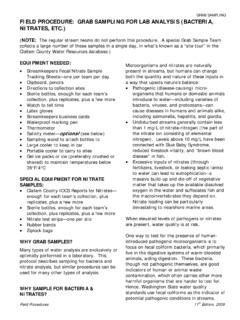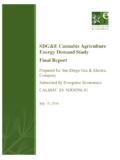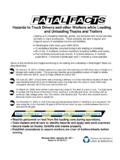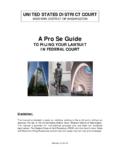Transcription of CONDUCTIVITY CHECK/CALIBRATION - Clallam …
1 J:\streamkeepers\Monitoring\Eqpt & supplies\ calibration -Maintenance\SOPs\Co nductivity SOP's\ CONDUCTIVITY 1 of 4 CONDUCTIVITY CHECK/CALIBRATION The YSI-85 tends to hold CONDUCTIVITY calibration fairly well, so calibrating at the beginning of the seasonal sampling month and checking at the end of that month should be adequate. If the instrument is used between seasonal sampling months, additional checking is recommended. First, gather the equipment you will need: 1. CONDUCTIVITY calibration Protocol & Data Sheets notebook 2. YSI-85 meters out of each field kit and OPI meter if available 3.
2 Purified water 4. Foaming bathroom cleaner 5. Small nylon brush to scrub inside CONDUCTIVITY chamber 6. CONDUCTIVITY Standard Solution * check date if opened. The solution expires one month after opening. If expired, get new solution. NEVER REUSE calibration SOLUTION. 7. You will also use a glass beaker or any clean glass or ceramic container. The container needs to be large enough to hold enough solution to immerse the probes in solution to completely cover the two holes right under the connecting cable. Checking prior calibration stability: 1. Record the date, your initials, season, CONDUCTIVITY standard strength and all meter numbers on the CONDUCTIVITY calibration data sheet.
3 2. Turn on the first meter and allow it to complete its self-test procedure. After the initial screen with all the 8 s, record the next number that shows on the screen (a number near 5); this is the pre- calibration CONDUCTIVITY cell constant. Repeat with each of the other meters. 3. Get out a clean glass or ceramic container. A 500 ml beaker works fine for 4-5 probes at a time. 4. Pour at least 3 inches of the calibration solution into the container, again making sure the solution is new or has not expired 5. Use the MODE button on the meters to advance the instrument to display the second CONDUCTIVITY screen; this is the specific conductance screen, with units in S and with a blinking C symbol.
4 J:\streamkeepers\Monitoring\Eqpt & supplies\ calibration -Maintenance\SOPs\Co nductivity SOP's\ CONDUCTIVITY 2 of 4 6. You can check the calibration of several units in the same solution successively; just make sure the units are well rinsed in purified water then shake them dry. 7. Place the probes into the solution, making sure that the two holes on the top of the probes are completely covered by the solution. Agitate the probes vigorously to release any trapped air bubbles. 8. Allow the probes time to stabilize their temperature (at least 1 minute) before checking the calibration .
5 Checking as close as possible to 25 C will minimize temperature compensation errors. Do not let the probes rest on the bottom of the container hold them at least inch above the bottom. 9. check and record the pre calibration CONDUCTIVITY readings with the probes in the CONDUCTIVITY solution. Record this value in the Pre column on the data sheet. 10. Now you will clean the CONDUCTIVITY cells prior to calibration . Cleaning Procedure: 1. Clean the CONDUCTIVITY cell next. a. Squirt foaming bathroom cleaner into the two CONDUCTIVITY vents near the connecting nuts on the probe. Let it sit for about 30 seconds.
6 B. Use the small nylon brush supplied with the unit to scrub the inside of the chamber; insert in holes and scrub back and forth. Then rinse the probe in purified water thoroughly. CONDUCTIVITY calibration steps: 1. Pour at least 3 inches of the calibration solution into the container, again making sure the solution is new or has not expired. 2. check and record the calibration CONDUCTIVITY readings with the probes in the CONDUCTIVITY solution. 3. Use the MODE button on the meters to advance the instrument to display the second CONDUCTIVITY screen; this is the specific conductance screen, with units in S and with a blinking C symbol.
7 J:\streamkeepers\Monitoring\Eqpt & supplies\ calibration -Maintenance\SOPs\Co nductivity SOP's\ CONDUCTIVITY 3 of 4 4. You can calibrate several units in the same solution successively; just make sure the units are well rinsed in purified water and thoroughly dried with lint-free tissues to prevent cross contamination. 5. Place the probes into the solution, making sure that the two holes on the top of the probes are completely covered by the solution. Agitate the probes vigorously to release any trapped air bubbles. 6. Allow the probes time to stabilize their temperature (at least 1 minute) before calibrating.
8 Calibrating as close as possible to 25 C will minimize temperature compensation errors. Do not let the probes rest on the bottom of the container hold them at least inch above the bottom. 7. Press and release the UP and DOWN arrow buttons on the meter at the same time. The CAL symbol will appear at the bottom left of the display to indicate that the meter is now in calibration mode. 8. Use the UP or DOWN arrow button to adjust the reading on the display until it matches the value of the calibration solution listed on the bottle which will usually be 1000 S/cm or 1,000 mhos. 9. Once the display reads the exact value of the calibration solution, press the ENTER button once.
9 The word SAVE will flash across the display for a second, indicating that the calibration has been accepted. (The meter will make the appropriate compensation for temperature variations from 25 C). 10. The meter should now be calibrated. For added assurance, rinse the probe in purified water, shake off excess water and take a reading in air only. It should be ZERO. If not, repeat calibration steps. 11. Record the post- calibration CONDUCTIVITY reading and the temperature; then switch each meter off and on again, and record the post- calibration CONDUCTIVITY cell constant that shows on the screen after all the 8 s have flashed.
10 12. Record the date of calibration and your initials on each meter by writing it on a sticker or white tape and securing it to the meter. J:\streamkeepers\Monitoring\Eqpt & supplies\ calibration -Maintenance\SOPs\Co nductivity SOP's\ CONDUCTIVITY 4 of 4 13. check the expiration dates on the CONDUCTIVITY standard unopened bottles to ensure there is enough for the next seasonal CONDUCTIVITY calibration . If there is not make sure you let the staff in the office know. 14. Once you have finished calibrating the equipment, YOU are responsible for entering the new data into the database.









